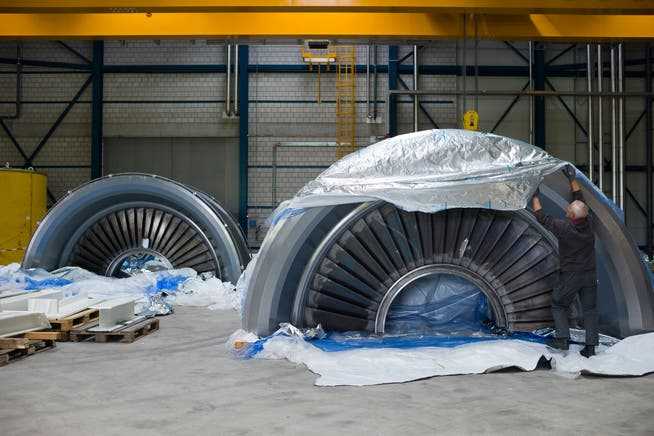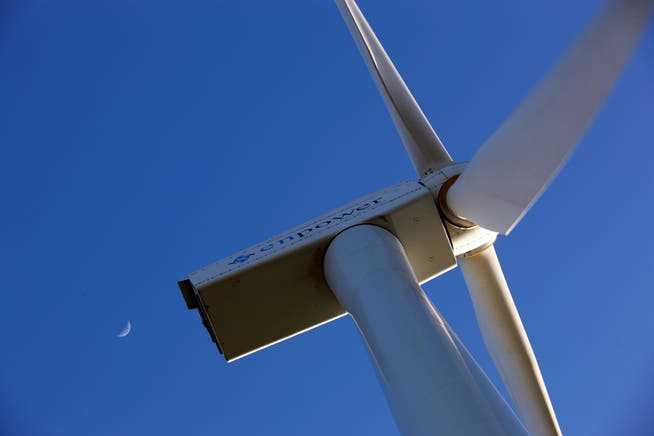Electricity prices fluctuate enormously. Electricity companies have to raise a lot of money so that they can continue to trade on the stock exchanges. The Swiss electricity company Alpiq even asked the federal government for help – now new regulations are imminent. We clarify the most important questions about the recent turbulence.
Cooling tower of the Leibstadt nuclear power plant in the canton of Aargau. The electricity companies sell their production years in advance – and then have to be able to deliver on time.
Towards the end of last year the energy markets went crazy. Increasing trends led to huge price increases in December. In this environment, electricity traders became increasingly nervous: They suddenly had a significantly higher need for funds in order to meet the financial security they needed to secure their positions on the energy exchanges.
Alpiq, the second largest Swiss electricity company after Axpo, even approached the Federal Electricity Commission (Elcom) with a request for a temporary liquidity subsidy. Federal Councilor Simonetta Sommaruga set up a task force from the administration and Elcom to examine the application. On January 3, Alpiq withdrew its application after the company from its shareholders 223 million Swiss francs and had secured the prospect of an increase to 300 million.
In mid-January, Sommaruga rounded up the CEOs and presidents of the boards of directors of domestic utilities in Bern. The Alpiq’s questionable request from a regulatory point of view has whetted the appetite of the authorities to keep a closer eye on the industry. In the electricity industry, there is great anger about Alpiq’s approach because it could provoke far-reaching regulatory restrictions.
Why have electricity prices recently multiplied?
At the beginning of the problems for the energy companies are the natural gas and electricity prices, which have literally exploded in the past year. The development of gas prices is particularly important for the electricity industry, because in the EU and thus also significantly for Switzerland, the wholesale price for electricity reflects the price of the last unit of electricity that is brought to the market. These are often gas-fired power plants that can be switched on flexibly to compensate for fluctuations in demand. This means that if gas prices rise, electricity prices will also rise.
The reasons for the price increases are the surprisingly strong economic recovery last year after the pandemic-related slump, failures in the EU’s own production of natural gas, a cold winter in 2020/21, strong gas demand from Asia and sluggish additional deliveries from Russia. On December 21, the European reference price for natural gas reached around 180 euros per megawatt hour. A year ago it was 17 euros, which corresponds to a long-term average. The deployment of Russian troops on the border with Ukraine aggravates the situation.
These events are also reflected in the electricity prices: In the EU, wholesale prices climbed to between 400 and 500 euros per megawatt hour on December 21, 2021. For comparison: In the summer it was 70 euros, in 2020 it was around 30 euros. There were other price-increasing factors on the electricity market, such as the record-high price for CO2-Emission certificates and the partial shutdown of nuclear power plants in France due to maintenance work.
Why do suppliers have to invest a lot of money?
Such price turbulence causes headaches for electricity producers like Alpiq: They sell most of their production two to three years in advance. This is necessary for a good that can only be stored to a limited extent, such as electricity, for which production and consumption must always be physically balanced.
Back then, when prices were rock bottom, an electricity company sold a megawatt hour for 30 or 40 euros, for example. Currently, however, a multiple of this is paid for electricity deliveries on the exchange. Because of the long time between sale and delivery of electricity, there is always a risk that the seller will not be able to deliver the promised amount at the appointed time. If the transaction was concluded via an exchange such as the Leipzig Energy Exchange (EEX, European Energy Exchange), this also makes the exchange operator nervous. Because he acts as an intermediary between buyer and seller, he is responsible for the fulfillment of the contracts.

The reactor of the Leibstadt nuclear power plant, photographed at the time of the annual inspection.
Suppose the producer suddenly has trouble delivering the agreed quantities on time. The exchange would then have to obtain replacement electricity for the buyer on the spot market and pay a multiple of the originally agreed price today. The stock market wants to protect itself against this risk.
The electricity traders must therefore deposit financial securities. The greater the difference between the market price and the delivery price agreed a few years ago, the higher the collateral required.
The electricity exchanges have enforced through these additional payment obligations that the electricity suppliers had to significantly increase their liquid funds. The amount of collateral depends on the price level and price fluctuations – both were and are very high. Trading participants say that the security requirements have increased eightfold within a few months.
Accordingly, many corporations had to secure access to additional funds at the end of the year, not only in Switzerland. The German Uniper even got 12 billion euros, including 2 billion euros from the state bank KfW.
Are electricity companies going bankrupt?
If you talk to market participants these days, you can still feel a certain nervousness despite somewhat flattening prices. Things could get uncomfortable if the additional deposits of collateral assumed even greater proportions. But the price of electricity is currently well below the highs of December. Rather, the industry seems to want to sit out the whole thing.
With every day that passes, the situation relaxes. Because contracts are continuously due: the electricity is supplied, which also means that the security deposit is repaid. It could become critical if there are still very cold winter days or if Russia invades Ukraine. Then price caprioles would have to be expected again on the electricity market. After the experiences in December, however, the larger corporations have saturated themselves with liquidity.
Basically, high electricity prices are a blessing for electricity producers. If they sell electricity for 2023 today, they could earn around 130 euros per megawatt hour, which promises profitable business. That’s why there was no sell-off in the shares of power companies in December. In that sense, it’s primarily a liquidity issue – but woe to those who still haven’t planned for it well.

Parts of a steam turbine are ready for installation, photographed on the site of the Leibstadt nuclear power plant.
Are the companies “too big to fail” and do they need to be more tightly regulated like the banks?
Energy Minister Simonetta Sommaruga has already announced that after December’s events she does not want to simply return to business as usual. in one interview with the Tamedia newspapers the SP Federal Councilor warned of a chain reaction if an important market participant were to fail: “That can endanger the security of supply.” The federal administration is now working with the regulatory authority Elcom to clarify whether new regulations are necessary for the electricity market.
The electricity companies could face a similar scenario as the big banks after the UBS rescue. As with the “too big to fail” regime for the systemically important financial institutions, it is a matter of implementing emergency plans. “The central question is how the continued operation of potentially system-critical functions – power plants as well as other services – can be ensured in the event of insolvency or debt restructuring proceedings,” says Elcom Managing Director Urs Meister.
However, electricity suppliers are not necessarily “too big to fail”. According to Meister, the systemic importance of a company not only depends on its size and business model, but also on how networked it is, for example through supply relationships with third parties.
Following the UBS rescue, Switzerland set binding capital requirements for systemically important banks. According to Meister, it is now also necessary to examine in the electricity industry whether regulatory requirements are needed to increase the financial resilience of energy suppliers. However, it should be borne in mind that the financial and electricity sectors differ significantly. A one-to-one transfer of the “too big to fail” regulation is therefore not to be expected.
As a further approach, the federal authorities are examining whether the regulatory framework for exchange trading should be adjusted. “However, such regulations would have to be closely coordinated internationally, since the electricity exchanges work across borders,” says Meister.
With the so-called Remit Regulation, the EU has already introduced extensive rules for wholesale electricity trading and European market monitoring. These are intended to ensure transparency in the market and prevent market manipulation. With the signing of the electricity agreement with the EU, Switzerland should have adopted the regulations. The breakdown of the negotiations on the framework agreement is preventing this for the time being. It remains open whether Switzerland is now striving to join the Remit rules.

Swiss power companies are investing heavily abroad: the Monte Mele wind farm in Sicily belongs to Alpiq.
What does the turbulence on the electricity market mean for Swiss consumers?
In contrast to the EU, most consumers in Switzerland are still trapped in a monopoly. So far, only large consumers who require at least 100 megawatt hours per year have been able to procure their electricity on the open market. Private households and smaller companies are not free to choose their suppliers. In addition, their tariffs are regulated. The local supplier can only charge consumers for the electricity they produce themselves at production costs plus a profit margin. The tariffs for consumers whose suppliers have their own electricity plants are correspondingly stable – in less turbulent times one would say: inflexible.
The situation is somewhat different for large industrial consumers from the chemical, glass and steel sectors, whose suppliers largely stock up on electricity on the market. According to estimates, a good half of the electricity that is sold in the basic supply comes from the free market. These customers hardly have anything to fear for the current year because the quantities have already been bought. However, if the high prices continue, sooner or later Swiss consumers will also feel the price increases.
